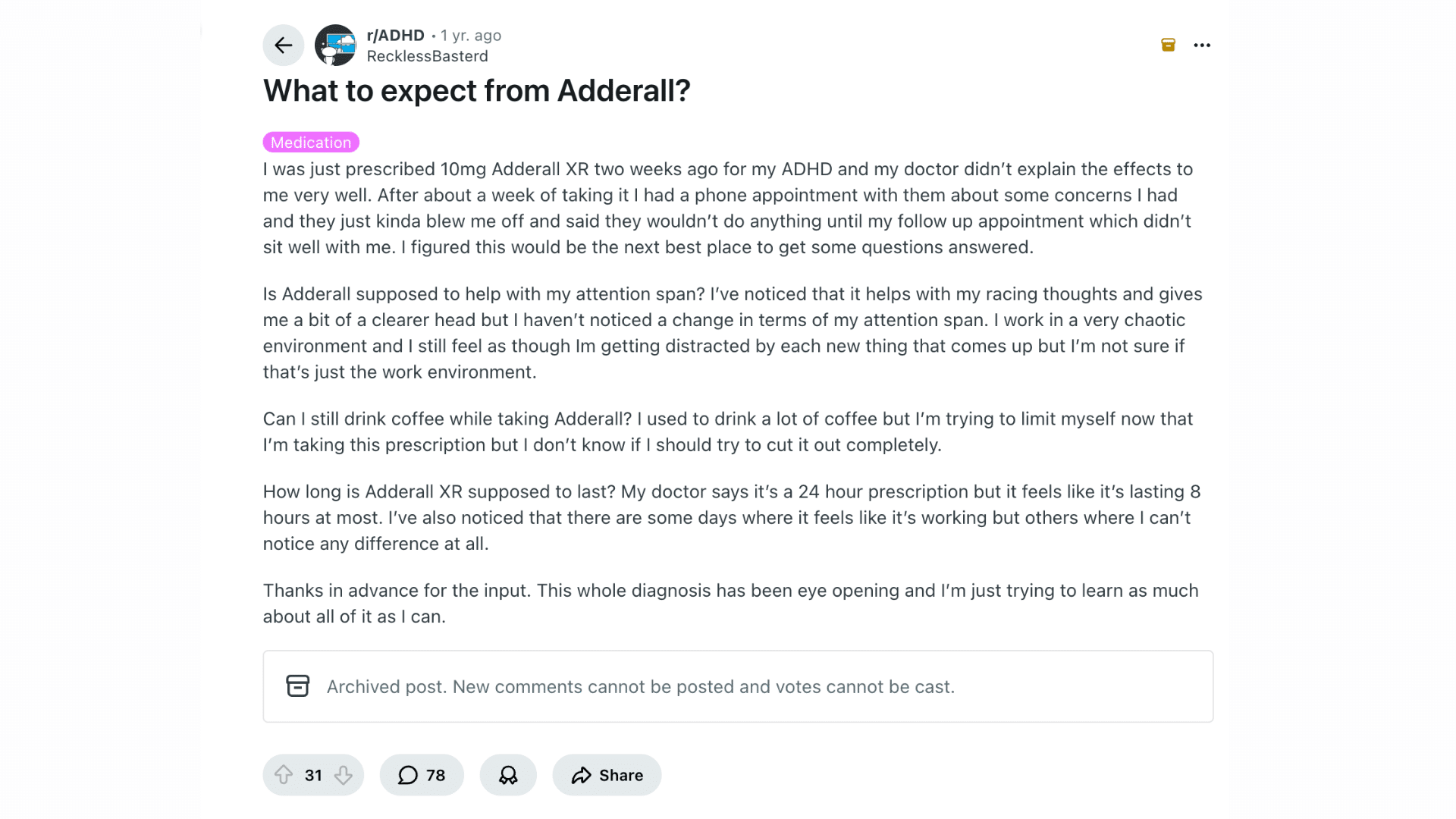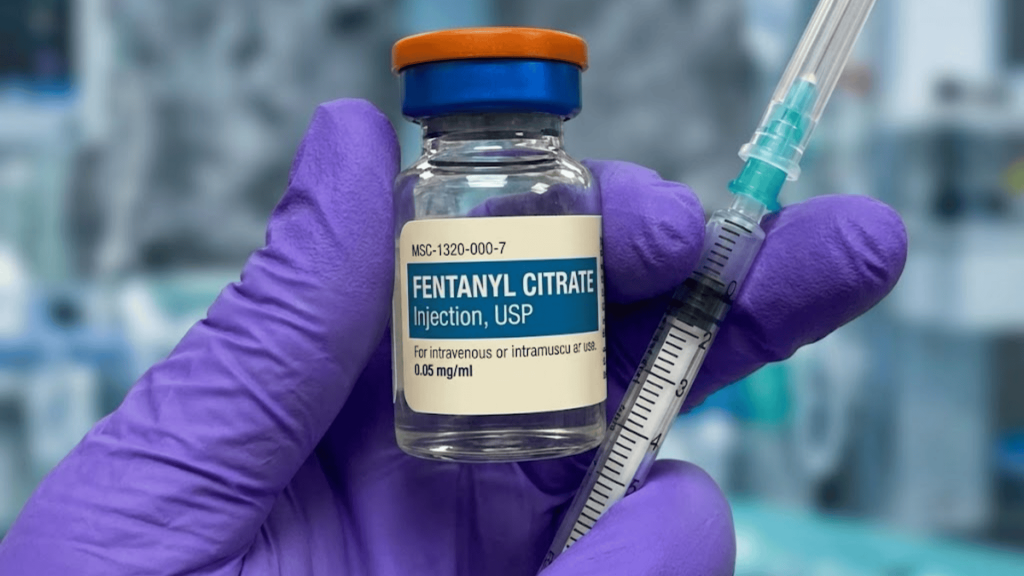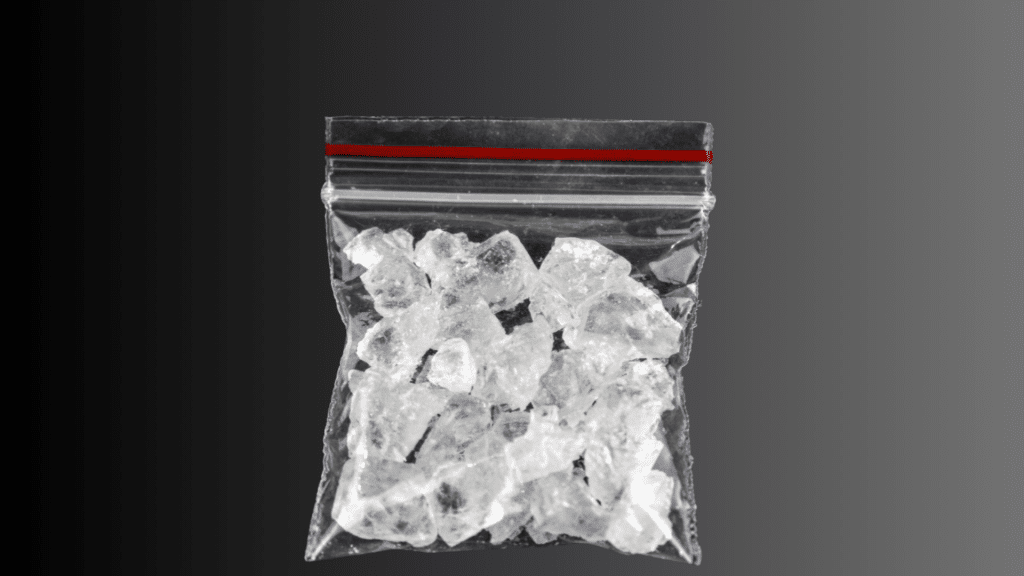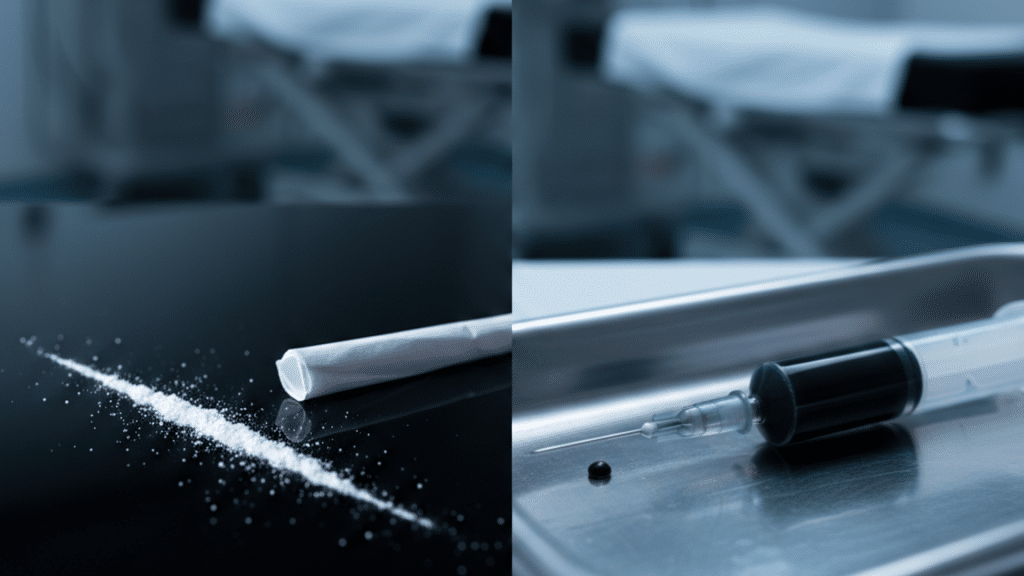Adderall has become one of the most recognized names in ADHD treatment, yet I’ve noticed how often people wonder about its effects on mood, and for good reason.
If you’re considering it for yourself, already taking it, or just curious about why your friend seems different on their medication, understanding the emotional side of Adderall matters.
I’ve seen countless discussions online where people share conflicting experiences: some feel more stable and focused, while others describe irritability or even depression. So what’s really happening in your brain when you take this medication?
In this guide, I’ll walk you through the science behind Adderall’s mood effects, examine both the short-term shifts and long-term patterns, and help identify when to consult your doctor.
How Does Adderall Work?
Adderall contains amphetamine salts that fundamentally change your brain chemistry. When you take it, the medication floods your brain with two key chemicals: dopamine and norepinephrine.
It does this in two ways: first by triggering neurons to release more of these neurotransmitters, then by blocking their normal reabsorption so they stick around longer. This surge sharpens your focus and motivation, which is why it helps with ADHD.
But here’s the catch: dopamine and norepinephrine don’t just control attention; they’re deeply involved in how you experience pleasure, reward, and emotional stability.
That’s precisely why Adderall can shift your mood in ways you might not expect.
Ways Adderall Can Be Linked to Depression

The relationship between Adderall and depression isn’t straightforward; it unfolds through several distinct pathways.
Some people experience mood dips as a direct result of how the drug works in their system, while others find that depression emerges when they stop taking it or take too much.
Let me break down the five main ways this connection shows up.
1. The Comedown Crash
When Adderall’s effects wear off, your brain experiences a sudden drop in dopamine and norepinephrine levels. Think of it like coming down from a caffeine high, but more intense.
Your neurons have been flooded with these mood-regulating chemicals for hours, and now they’re depleted. This creates a temporary window where you might feel flat, irritable, or sad, especially in the evening as your dose fades.
Many people describe feeling emotionally drained or unmotivated during this period, even if they felt fine earlier in the day.
Immediate Symptoms: Fatigue, sadness, irritability, and lack of motivation appear predictably as medication wears off each day.
2. Withdrawal Depression
If you stop taking Adderall suddenly after regular use, your brain struggles to produce normal dopamine levels on its own. It’s become accustomed to the medication doing that work.
During withdrawal, you may experience sustained depressive symptoms that last days or weeks, not just hours like the daily comedown. This happens because your brain needs time to recalibrate its natural neurotransmitter production.
People who’ve taken higher doses or used Adderall for longer periods typically face more intense withdrawal depression.
Immediate Symptoms: Persistent low mood, anhedonia, extreme fatigue, and difficulty finding pleasure in activities lasting beyond a single day.
3. Misuse and High-Dose Effects
Taking Adderall in ways not prescribed, higher doses, more frequent use, or non-medical purposes, can destabilize your brain chemistry.
Excessive dopamine surges followed by crashes create a volatile cycle that disrupts normal mood regulation. Your brain’s reward system becomes dysregulated, making it harder to feel good without the drug.
Over time, this pattern can trigger genuine depressive episodes. Students cramming for exams or people using it recreationally face particular risk here.
Immediate Symptoms: Mood swings, increasing emotional instability, depression that worsens despite continued use, and growing need for higher doses.
4. Unmasking Underlying Depression
Sometimes Adderall doesn’t cause depression; it reveals it. When ADHD symptoms like distractibility and restlessness improve, you might finally notice the depression that was always there but overshadowed.
Before treatment, your racing thoughts or constant need for stimulation may have masked feelings of sadness or emptiness.
Once your mind quiets down, those underlying mood issues become impossible to ignore. This is actually a diagnostic opportunity, not a medication failure.
Immediate Symptoms: Emerging awareness of persistent sadness, hopelessness, or emptiness after initial improvement in focus and attention.
5. Direct Adverse Reaction
Though less common, some people simply react to Adderall with depression as a direct side effect. The FDA lists depression among possible adverse reactions, meaning it can occur without the patterns described above.
Your individual brain chemistry might respond differently to amphetamines than expected.
This type of depression typically appears soon after starting the medication or increasing the dose, and it doesn’t follow the predictable crash-and-recovery pattern.
Immediate Symptoms: New-onset depression beginning shortly after starting Adderall or dose changes, without a clear temporal pattern to medication timing.
Short-Term Effects: Comedown, Crash, and Transient Low Mood

The most common mood issue people face with Adderall happens predictably every day: when the medication wears off. This isn’t exactly clinical depression, but it can feel similar, leaving you drained and emotionally numb.
What the Comedown Actually Feels Like
As your brain transitions from elevated neurotransmitter levels back to baseline, you experience a noticeable shift in how you feel and function.
- Fatigue and Mental Fog: Energy crashes hard, making simple tasks overwhelming, and sharp focus dissolves into sluggish thinking
- Irritability and Emotional Flatness: Small annoyances become unbearable, or you feel emotionally numb and withdrawn from others
- Anhedonia and Lost Motivation: Normal activities lose their appeal as your temporarily depleted reward system stops providing satisfaction
These symptoms typically fade within hours as brain chemistry stabilizes.
When and Why It Happens
The comedown follows a predictable pattern tied directly to how Adderall moves through your system and your individual biology.
- Timing Varies by Formulation: Immediate-release crashes around four to six hours post-dose; extended-release creates gentler declines at eight to twelve hours
- Does Strength Matter: Higher doses create dramatic dopamine spikes and steeper crashes; minimal doses produce barely noticeable comedowns
- Individual Differences: Your metabolism speed, neurotransmitter sensitivity, and baseline dopamine production all influence crash severity
Recognizing these patterns helps you adjust timing, dosage, or formulation with your doctor.
Withdrawal & Longer-Lasting Depressive Symptoms
When you stop taking Adderall after regular use, your brain doesn’t immediately bounce back to normal.
It has adapted to the medication’s presence, and suddenly removing that chemical support creates a withdrawal period that can feel like genuine depression.
| Aspect | What Happens | Timeline | Severity Factors |
|---|---|---|---|
| Brain physiology | Downregulated dopamine/norepinephrine production; baseline levels drop below normal | Starts within 24-48 hours of the last dose | Worse with higher doses and longer use |
| Acute symptoms | Severe fatigue, hypersomnia, low mood, increased appetite | Peak at 2-4 days; improve over 1-3 weeks | Abrupt cessation intensifies symptoms |
| Psychological effects | Anhedonia, difficulty concentrating, and loss of motivation |
Can persist for months in misuse cases | Co-occurring mental health worsens the duration |
| Safe tapering | Gradual dose reduction under medical supervision | Weeks to months, depending on dose | Minimizes withdrawal severity significantly |
If depressive symptoms persist beyond several weeks after stopping, that likely reflects an underlying mood disorder rather than withdrawal alone.
Misuse, High Doses, Tolerance, and Neurobiology

Taking Adderall beyond prescribed guidelines creates a cascade of neurological changes that go far beyond simple dependence.
The brain’s reward system becomes fundamentally altered, making depression not just a side effect but an almost inevitable consequence.
- Tolerance Builds As Your Brain Adapts: Repeated dopamine surges reduce receptor sensitivity, requiring higher doses for the same effect
- Reward Circuitry Dysregulation: Chronic overstimulation damages your natural ability to experience pleasure from everyday activities
- Dependence Traps You In A Cycle: Your brain stops producing adequate baseline dopamine, making you feel depressed without Adderall
- Self-Medication Worsens Outcomes: Using Adderall for undiagnosed depression creates a feedback loop that deepens mood instability
- Polydrug Interactions Compound Risks: Combining with alcohol, benzodiazepines, or opioids dramatically increases depression and withdrawal severity
The neurobiology here is unforgiving; pushing your dopamine system beyond its limits doesn’t just create temporary problems.
You’re fundamentally reshaping how your brain processes reward and motivation, changes that can take months or years to reverse, even after stopping.
Evidence From Studies & Clinical Literature
The research on Adderall and depression presents a complex picture.
Some studies show stimulants can improve depressive symptoms in specific cases, particularly as augmentation therapy for treatment-resistant depression or when ADHD coexists with mood disorders, according to research published in peer-reviewed medical journals.
However, other literature from the National Institutes of Health documents paradoxical mood worsening, especially with prolonged use or higher doses.
The critical factor is heterogeneity: outcomes depend heavily on whether you actually have ADHD, your baseline mental health, dosage, duration, and individual neurochemical vulnerability. What helps one person’s mood might destabilize another’s.
Online Community Talking About Adderall

Online forums reveal diverse Adderall experiences. Reddit users at https://www.reddit.com/r/ADHD/ frequently describe comedown depression, emotional numbness, or unmasked underlying sadness, while others report mood improvement with proper dosing.
These accounts offer valuable context for understanding individual variation but shouldn’t replace clinical evidence.
Anecdotal reports help clinicians recognize patterns patients experience, but lack the controls necessary for determining causation or predicting outcomes.
They’re useful conversation starters with your doctor, not definitive answers about how Adderall will affect your specific brain chemistry.
Risk Factors that Raise the Chance Adderall Will Worsen Mood
Certain conditions and behaviors significantly increase your vulnerability to Adderall-related depression. Understanding these risk factors helps you and your doctor make informed decisions about treatment safety.
- Pre-Existing Mood Disorders: History of major depression or bipolar disorder increases risk, as stimulants can destabilize bipolar mood cycles.
- High Doses or Misuse: Taking more than prescribed or using nonmedically disrupts brain chemistry beyond therapeutic levels.
- Abrupt Discontinuation: Stopping suddenly or missing doses creates volatile mood swings and intensifies crashes.
- Medication Interactions: Combining with SSRIs or MAOIs creates complex effects and serotonin syndrome risk.
- Genetic Vulnerability: Family history of substance dependence or individual sensitivity to dopamine changes amplifies adverse mood responses.
If multiple risk factors apply to you, discuss alternative treatments or enhanced monitoring with your healthcare provider before starting or continuing Adderall.
Clinical Approach: Diagnosis, Management & When To Seek Help
Determining whether Adderall is causing mood changes requires careful clinical evaluation.
Your doctor will examine your history, medication timeline, and symptom patterns to distinguish between drug effects, withdrawal, unmasked depression, or other causes.
| Clinical Area | Strategy | Action |
|---|---|---|
| Diagnosis | Timeline analysis, symptom rating scales | Correlate mood changes with dose timing and medication start date |
| Dose Adjustment | Switch formulations or modify schedule | Try extended-release to reduce comedowns |
| Safe Tapering | Gradual reduction under supervision | Prevent withdrawal; never stop abruptly |
| Depression Treatment | Add antidepressants or therapy | Address mood separately from ADHD |
| Misuse Support | Specialized addiction programs | Treat substance use and underlying issues |
Seek immediate medical attention for suicidal thoughts, severe functional impairment, or psychosis symptoms. These are psychiatric emergencies requiring urgent care.
Practical Advice For Patients & Prescribers
Smart medication management can minimize mood-related risks while maximizing therapeutic benefits. These evidence-based strategies help both patients and clinicians navigate Adderall treatment safely.
- Start Low, Go Slow: Begin with minimal doses and increase gradually while monitoring mood closely after each change.
- Maintain Consistent Dosing: Take medication at the same times daily; consider smoother options like Vyvanse for severe comedowns.
- Never Stop Abruptly: Always consult your prescriber for a tapering plan before discontinuing.
- Track Your Mood Daily: Use journals or apps to document patterns and communicate changes to your doctor promptly.
- Schedule Regular Check-Ins: Meet with your prescriber frequently during the initial months to assess both therapeutic effects and mood impacts.
Open communication between patients and prescribers is essential; honest reporting of mood changes allows for timely adjustments that keep treatment both effective and safe.
The Bottom Line
I’ve walked you through the complex relationship between Adderall and depression, from the neurochemistry behind mood shifts to the practical steps you can take right now.
The key takeaway? Your experience with Adderall is highly individual, shaped by your unique brain chemistry, dosage, and underlying mental health.
If you’re noticing mood changes on this medication, you’re not imagining things, and you’re not alone.
Document what you’re feeling, talk openly with your prescriber, and remember that finding the right treatment often requires patience and adjustment.
Have you experienced mood changes on Adderall? Share your story in the comments below; your experience might help someone else facing similar challenges.









